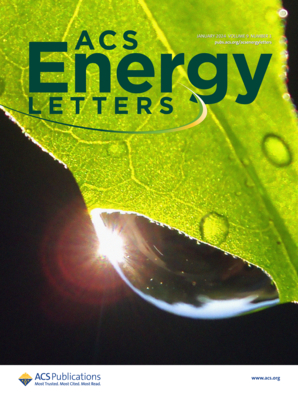Plasma-Assisted Surface Nitridation of Proton Intercalatable WO3 for Efficient Electrocatalytic Ammonia Synthesis
IF 18.2
1区 材料科学
Q1 CHEMISTRY, PHYSICAL
引用次数: 0
Abstract
Electrocatalytic nitrogen reduction (eNRR) offers a green pathway for the production of NH3 from N2 and H2O under ambient conditions. Transition metal oxynitrides (TMOxNy) are among the most promising catalysts but face challenges in achieving a high yield and faradaic efficiency (FE). This work develops a hybrid WOxNy/WO3 catalyst with a unique heterogeneous interfacial complexion (HIC) structure. This design enables in situ generation and delivery of highly active hydrogen atoms (H*) in acidic electrolytes, promoting nitrogen hydrogenation and the formation of nitrogen vacancies (Nv) on the WOxNy surface. This significantly enhances the selectivity of eNRR for NH3 synthesis while suppressing the hydrogen evolution reaction (HER). A simple two-step fabrication process─microwave hydrothermal growth followed by plasma-assisted surface nitridation─was developed to fabricate the designed catalyst electrode, achieving an NH3 yield of 3.2 × 10–10 mol·cm–2·s–1 with 40.1% FE, outperforming most TMN/TMOxNy electrocatalysts. Multiple control experiments confirm that the eNRR follows an HIC-enhanced Mars–van Krevelen (MvK) mechanism.

等离子体辅助表面氮化质子插层WO3用于高效电催化合成氨
电催化氮还原(eNRR)为环境条件下N2和H2O生成NH3提供了一条绿色途径。过渡金属氮氧化物(TMOxNy)是最有前途的催化剂之一,但在实现高产率和法拉第效率(FE)方面面临挑战。本研究开发了一种具有独特非均相界面肤色(HIC)结构的WOxNy/WO3杂化催化剂。这种设计能够在酸性电解质中原位生成和传递高活性氢原子(H*),促进氮氢化和在WOxNy表面形成氮空位(Nv)。这显著提高了eNRR对NH3合成的选择性,同时抑制了析氢反应(HER)。采用微波水热生长-等离子体辅助表面氮化两步制备工艺制备了所设计的催化剂电极,其NH3产率为3.2 × 10-10 mol·cm-2·s-1, FE为40.1%,优于大多数TMN/TMOxNy电催化剂。多个对照实验证实,eNRR遵循hic增强的Mars-van Krevelen (MvK)机制。
本文章由计算机程序翻译,如有差异,请以英文原文为准。
求助全文
约1分钟内获得全文
求助全文
来源期刊

ACS Energy Letters
Energy-Renewable Energy, Sustainability and the Environment
CiteScore
31.20
自引率
5.00%
发文量
469
审稿时长
1 months
期刊介绍:
ACS Energy Letters is a monthly journal that publishes papers reporting new scientific advances in energy research. The journal focuses on topics that are of interest to scientists working in the fundamental and applied sciences. Rapid publication is a central criterion for acceptance, and the journal is known for its quick publication times, with an average of 4-6 weeks from submission to web publication in As Soon As Publishable format.
ACS Energy Letters is ranked as the number one journal in the Web of Science Electrochemistry category. It also ranks within the top 10 journals for Physical Chemistry, Energy & Fuels, and Nanoscience & Nanotechnology.
The journal offers several types of articles, including Letters, Energy Express, Perspectives, Reviews, Editorials, Viewpoints and Energy Focus. Additionally, authors have the option to submit videos that summarize or support the information presented in a Perspective or Review article, which can be highlighted on the journal's website. ACS Energy Letters is abstracted and indexed in Chemical Abstracts Service/SciFinder, EBSCO-summon, PubMed, Web of Science, Scopus and Portico.
 求助内容:
求助内容: 应助结果提醒方式:
应助结果提醒方式:


